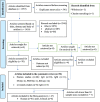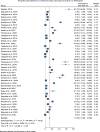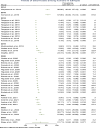Epidemiology of arboviruses in humans and livestock in Ethiopia: a systematic review and meta-analysis
- PMID: 40175900
- PMCID: PMC11967150
- DOI: 10.1186/s12879-025-10824-7
Epidemiology of arboviruses in humans and livestock in Ethiopia: a systematic review and meta-analysis
Abstract
Background: Arbovirus infections are a global public health threat, accounting for approximately 73% of the total emerging and re-emerging human infections, where the burden is worsened in sub-Saharan Africa, including Ethiopia. However, the surveillance system has been still challenged, and their burden and magnitude are not well estimated due to underestimates of true arbovirus burdens by passive case detections. To support targeted evidence-based public health decision-making, comprehensive evidence of arbovirus prevalence is crucial. Thus, the aim of this study was to assess the prevalence of arboviruses in humans and livestock in Ethiopia.
Method: Articles were extensively searched in bibliographic databases and gray literatures using entry terms or phrases. PRISMA 2020 flow diagram was used and data among studies meeting eligibility criteria extracted in MS Excel sheet and exported into STATA-17 software for analysis. A random-effects model was used to compute the pooled magnitude of arboviruses in humans and livestock. The heterogeneity was quantified using the I2 value. Publication bias was assessed using a funnel plot and Egger's test. Sensitivity analysis, subgroup analysis and meta-regression were performed to explore heterogeneity.
Result: Of the 1957 studies identified, 39 human and 6 livestock studies were eligible for meta-analysis. The overall pooled sero-epidemiology of arboviruses in humans using anti-IgG and anti-IgM was 15.43% (95% CI: 12.11-18.76) and 10.04% (95% CI: 6.46-13.62), respectively. The molecular prevalence of arboviruses in humans was 38.42% (95% CI: 21.77-55.08). The pooled prevalence of arboviruses in livestock was 15.77% (95% CI: 0.45, 31.08). Dengue virus, Yellow fever virus, Zika virus, Rift valley fever, West Nile virus, and chikungunya virus in humans and Rift valley fever, West Nile virus, and Schmallenberg virus in livestock were reported.
Conclusion: The magnitude of arboviruses in humans and livestock in Ethiopia alarms the need for immediate multi-sectoral interventions such as strengthening laboratory diagnostic capacities, undertaking an integrated regular national surveillance, and implementation of one-health initiatives and a planetary health approach.
Keywords: Arboviruses; Ethiopia; Human; Livestock; Systematic review and meta-analysis.
© 2025. The Author(s).
Conflict of interest statement
Declarations. Ethics approval and consent to participate: Not applicable. Consent for publication: Not applicable. Competing interests: The authors declare no competing interests.
Figures










References
-
- Tajudeen YA, Oladipo HJ, Oladunjoye IO, Yusuf RO, Sodiq H, Omotosho AO, et al. Emerging arboviruses of public health concern in Africa: Priorities for future research and control strategies. Challenges. 2022;13(60):1–11.
-
- Shepard DS, Undurraga EA, Halasa YA, Stanaway JD. The global economic burden of dengue: a systematic analysis. Lancet Infect Dis. 2016;16(8):935–41. - PubMed
-
- Roiz D, Pontifes P, Jourdain F, Diagne C, Leroy B, Vaissière A-C, et al. The rising global economic costs of Aedes and Aedes-borne diseases. 2023. - PubMed
-
- Thompson R, Martin Del Campo J, Constenla D. A review of the economic evidence of Aedes-borne arboviruses and Aedes-borne arboviral disease prevention and control strategies. Expert review of vaccines. 2020;19(2):143–62. - PubMed
Publication types
MeSH terms
LinkOut - more resources
Full Text Sources

